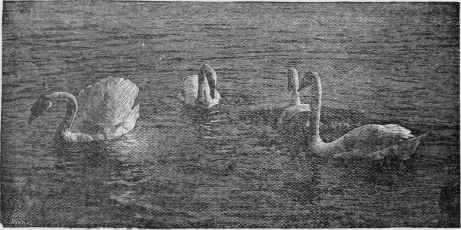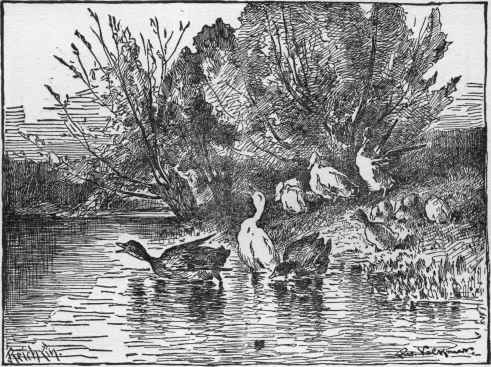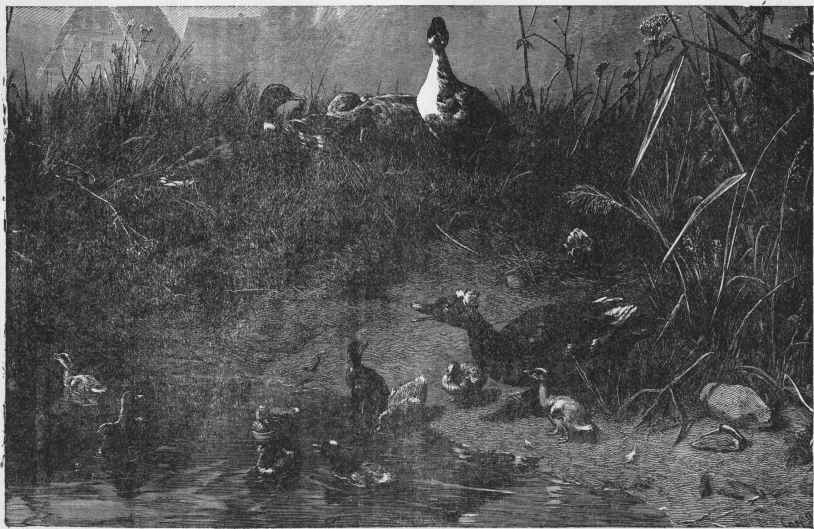DUCKS.
Advantages of Ducks...... 294
Aylesbury Ducks........ 295
Care of Ducks....... . . 295
Cayuga Ducks......... 296
Feeding of Ducks........ 295
General Duck-Raising ...... 294
Housing of Ducks...... . 294
Important Features of Duck-Raising . 298
Mode of Feeding........ 295
Muscovy Ducks........ 296
Mandarin Ducks . ....... 294
Management of Ducks...... 294
Method of Dressing Ducks .... 294
Pekin Ducks......... 292
Raising Ducks by the Incubator ... 294
General Duck-Raising.—The public, only in the
last few years, have awakened to the importance of
the duck-raising interest in this country.
Formerly it was supposed to be of small propor
tions, as compared to the beef, pork and poultry
product.
This industry, if we may so call it, is vastly on
the increase year by year, and duck culture assumes
a most important part in the fancier's business.
People within a few years did not think ducks
were fit to eat; but the public is fast beginning
to know the fact that a nice roasted duckling, of
about ten weeks old, is ahead of any other kind of
bird or fowl. Thus, this sudden popularity of the
bird in our markets, the great demand for them by
the people, and the profits that can be realized from
raising them, led me to advise each and every farmer,
and those people who have the room, to keep ducks,
and in consideration of this I will take up duck
raising by artificial means, showing forth experiences
of different men in the business for the last 20 years.
The first thing to be remembered in raising
ducks is the fact that it is no child's play; that the
care of ducks and chickens means early hours and
late ones. The closest application and confine
ment are necessary for at least six months in the
year; and if one is afraid of hard work and soiling
his fingers, do not let him go into duck-raising, for
he had better stay where he is.
It is no occupation, as supposed, for little children.
girls or boys ; but it requires the attention of a good,
strong man.
Advantages of Ducks.—If the hen is confined, she
will grow drowsy, lose her ambition, and spend the
most of her time on the roost. However, with a
duck this is just the opposite. She is constantly
in motion, and continually keeps in exercise. She
is satisfied in snow and ice, which is not true of
the hen. She likes nothing better than to be out
on the snowbank during a thaw; she does not
mind the cold, only wishing to keep her feet warm.
Her feathers and coat of down keep her body warm
in all kinds and conditions of weather. She does
not like confinement, and would rather be in the
cold than in the heat of the house.
This is mentioned concerning the duck to show
the reader the nature, and the kind of a house to
build for his ducks.
The first requisite is to keep the ducks’ feet
warm; for if they have cold feet it affects them as a
frozen comb does a hen, namely, that it stops their
laying.
In the arranging of the buildings the only things
to keep in mind are, that they should be as warm as
possible, dry as possible; with a view of always
having room enough to lengthen out, in case you
should wish to enlarge your flock.
A very good house is arranged so that a person
should have as little walking to do as possible, and
is built after this method, namely: that it is about
DUCKS.
295
1oo feet long and 20 feet wide. On one side, tak
ing up about three feet in space, is a walk running
the whole length of the house. The remaining
space is divided into pens, separated from one an
other by lath or wire-netting each one of these
pens is entered by a door from this passage-way,
giving access to each separate pen, thus enabling
one to keep the different varieties separate. One or
more of these pens may be given up entirely to set
ters if so desired.
On the side of the pen, next to the walk, there
can be arranged boxes as nests, opening from the
back into the walk by a board let down by a hinge,
so that it does not necessitate the person going in
the pens to collect the eggs; but by walking through
the passage-way, and letting down the different
boards, he can gather all the eggs there are.
Care, however, should be taken to arrange a

Swans.
slanting board on the top of these boxes arranged
as nests, to prevent the birds from going on top of
them.
The majority of people have the impression that
ducks’ eggs are unfertile unless there is water to
bathe in. This, however, is a great mistake, as a
great many fanciers keep their birds in confinement,
giving only water enough for drinking purposes.
It has also been found that free range is unneces
sary for the fowls, and that they do as well in con
finement and better, than as though they were
allowed at roam at large.
The Mode of Feeding varies at different seasons
of the year. In autumn and the winter months it
is well to feed twice a day equal quantities of corn-
meal, bran and potatoes ; then about noon it is
well to give dry food, such as corn, oats and wheat.
About June first, however, it is better to decrease
the amount of bran, and increase the amount of
animal food and the quantity of meal.
One of the most important points about ducks
is, that they will not produce the proper percentage
of fertile eggs if fed on hard food alone. The nat
ural food of the ducks is purely vegetable and ani
mal, and is obtained in swampy places. The duck
has no crop like the hen, and is not so well fitted
to thrive on hard food. It is essential also to
feed ducks for breeding, and ducks for the market.
One object is to make them weigh the more, the
other is to give them material for egg supply.
It is always well to give the ducks, during the
molting-season, a complete and retired rest, giving
soft feed and plenty of green food.
Aylesbury Ducks.—This is one of the best breeds
of English ducks. Although they are more degen
erate in size in this country, yet by careful selection
in breeding, using only the largest and strongest
birds, this tendency may be obviated. They are
not quite as large as the Rouen variety, although
they so nearly equal them in this respect that they
often weigh 18 pounds per pair.
Their plumage is of a pure white; and they are
good layers, the eggs being pure white and of thin
shell. They have flesh-colored bills, and legs of
orange hue. They are oval in shape, with a broad,
long back, full, round breast, strong wings and short
straight legs. This duck is prone to fall down be
hind, by the stretching of the abdominal muscles,
and care should be taken in breeding to avoid such
birds. When ducks are like this, they should be
killed and dressed for market, because they are
liable to lay unfertile eggs.
These ducks commence laying in February and
continue for about five months with two to three
brief intervals. They are excellent foragers, and
will return regularly at night to their home.
Rouen Ducks.—This breed of ducks, sprung from
the Mallard or Gray duck, to which in color one sees
296
THE FRIEND OF ALL
a close resemblance. It is like the wild duck with
its weight increased. The plumage is very beauti
ful. The head is long, and in the dark is of a lumi
nous-green color. The bill is long and broad, of a
greenish-yellow hue, wider at the end than at the
base; the neck is long and slender the same as the
head, with a white ring on the lower part that does
not quite meet in the back. The upper part of the
back is ashy-gray blended with green. The breast
is broad and deep; the body broad, long and deep.
The wings are grayish-brown in color, blended with
green also. The plumage of the thighs is gray; the
legs and feet, orange with a slightly bluish tinge.
This breed of ducks does not come to maturity

Morning Bath.
quite as early as the Aylesbury, but is prolific, laying
eggs of a rather thick shell, bluish-green in color.
They, too, are excellent foragers.
These have very good market value, the flesh
being very delicate, and the birds are easily fat
tened. These, too, are apt to fall down behind.
Pekin Ducks.—This breed of ducks was imported
into this country from China. They are very hardy,
easily reared, excellent table fowl and good layers,
while their crop of feathers is nearly as great as
that of an ordinary goose. They are white in plu
mage and are very large, although not as large as
the two former breeds just mentioned, although they
seem to be on account of their feathers being loose
and fluffy.
Their eggs hatch well, the ducklings raise easily,
and mature rapidly, and in six weeks are larger than
any other breed. This makes them of excellent
market value. They need no water, cannot fly or
climb fences, and are easily restrained.
Cayuga Ducks.—This is an American breed, and
has long been raised in the United States and
Canada. They are entirely a water-duck, and sel
dom come on land.
The head is small and slender, the bill broad,
short and dark. The plumage is metallic-black,
with green reflections on the head and neck and
wings ; legs are dark, head of black. They are ex
tremely hardy, early in maturity, prolific layers, and
their flesh has a rich game flavor, but when dressed
for market their skin is quite yellow.
They are not an advisable breed to raise on land ;
but in the vicinity of lakes, ponds and streams, they
are quite practical and best to raise.
The Muscovy Duck.—The Muscovy duck is some
times called the Musk, or Brazilian duck. They
are large and handsome, the color being a rich dark
blue-black with a white bar on each wing.
In the drake, the feathers in the back are fine
and plumy, the legs and feet are dark, and they
have little to recommend them except their being
hardy and good layers.
A characteristic by which they may be easily dis
tinguished, is the red membrane surrounding the

Happy Duck Family.
298 THE FRIEND OF ALL
eyes and covering the cheeks. They never quack,
and are favorites with those who like eccentricities.
Their flesh is good, and they may be said to be
nearly equal in egg production.
The Mandarin Ducks.—These are a Chinese vari
ety, and are common in this country. The head is
a long crest pointing backwards, which can be
raised or lowered at will; the color of this crest is
green and purple on top, shading into a chestnut
and green. The feathers of the back are brilliant
light brown, and the under parts white or nearly so.
The quills or secondaries are brownish gray, edged
on the lower web with white. The bill is crimson,
the legs a lightish pink, and the back black. The
garb of the duck is much plainer, being a mottling
of greenish brown, with grayish under parts.
About May the drake loses his conspicuous
feathers, even his wings, fans and crest, and be
comes very much like the female; in August he
again assumes his fine clothing, and by September
is in full plumage.
Management of Ducks.—A brood of young ducks
in a garden would well pay their raising, merely as
insect destroyers. When kept in confinement they
are not as profitable as poultry, because they will
consume more food and lay less eggs. Ducklings
mature rapidly, and at six months old are ready for
market.
It is better to set ducks’ eggs under hens, cochins
or brahmas, the brahmas being preferred. The
breeding-ducks should be kept in their yards in the
morning until about 10 a.m. by which time they
will have laid their eggs, after which they can have
their liberty. It is a good plan to keep them lay
ing all the breeding-season, and to set their eggs
under hens.
In setting hens, they should be given from 12 to
15 eggs; there should be sufficient water for the duck
to bathe in, and food placed near at hand. The
usual time for incubation is 28 days. When hatch
ing, the duckling ought not to be disturbed for at
least 24 hours, at the end of which time they are
ready for their first meal, which should consist of
hard boiled eggs and bread crumbs soaked in
milk.
After 4 or 5 days old, give them oatmeal fixed
with milk, and other warm food. They will feed
on dirt, grass, and insects ; it is a good plan to
give them a run in the garden each day.
Ducks should be fed every night when they re
turn from their foraging expedition, which will in
sure their regular return. When two months old,
coarser feed may be given. All ducks are the
heaviest and fattest in December. Later, as the
breeding-time approaches, they will become lighter,
and on this account will they lay better.
In raising ducks by incubation, the method is the
same as in raising chickens, except that the time of
hatching is longer, taking 7 days more ; in raising
ducks, the incubator which has a nursery below the
egg-tray is the one to use by all means, as re
moving the duckling from the trays so reduces the
temperature of the incubator as to chill the remain
ing eggs. Forcing the bird to lay its eggs, re
duces the vitality of the eggs, and hence a poor
hatch of ducklings results.
It is absolutely necessary, in order to produce
healthy, vigorous young ducklings, to have good
breeding-stock ; for no living man can afford to breed
from unfertile stock. Another essential is the car
ing for the ducklings when hatched, and seeing that
the breeder is not too warm, lest death follow from
overheating and overcrowding.
Special care should be taken of the sanitary
arrangement of your house. All ducklings should
be kept as clean and healthy as possible.
There is great necessity of feeding green food;
and it is always well as rye comes the first in the
season, to give it. One would be astonished to
see how much green fodder ducks can make away
with.
Care is one of the important features of duck-
raising. It is especially necessary that all ducks
should have a bounteous supply of water; they will
consume and waste vast quantities, and the supply
should be made as convenient and as great as pos
sible. Shade is also absolutely necessary for the
ducks.
Method of Dressing Ducks.—The process is very
simple; all that is necessary is a chair and a large
box and a few knives; one knife should be double-
edged and sharp-pointed. For the bleeding, let
the man take the bird between his knees, the bill
held down with the left hand, and make a cut across
the roof of the mouth just below the eyes. The
bird should then be struck on its head in order to
stun it, the man taking the bird in his lap, its
head held down firmly between one knee and the
box. He should then go to work as soon as possi
ble, and have the bird well plucked by the time it
is dead.
All feathers should be carefully sorted while pick
ing, the wing and tail feathers and the pins thrown
away, the body feathers with the down thrown into
the box. Some of the pins cannot be taken out
without tearing the skin, and these together with
the down should be shaved off.
When the bird has been picked, it should be
turned into a barrel or basket of floating ice; this
will harden it so that its outline will be well
preserved.
But first, if you want to come back to this web site again, just add it to your bookmarks or favorites now! Then you'll find it easy!
Also, please consider sharing our helpful website with your online friends.
BELOW ARE OUR OTHER HEALTH WEB SITES: |
Copyright © 2000-present Donald Urquhart. All Rights Reserved. All universal rights reserved. Designated trademarks and brands are the property of their respective owners. Use of this Web site constitutes acceptance of our legal disclaimer. | Contact Us | Privacy Policy | About Us |